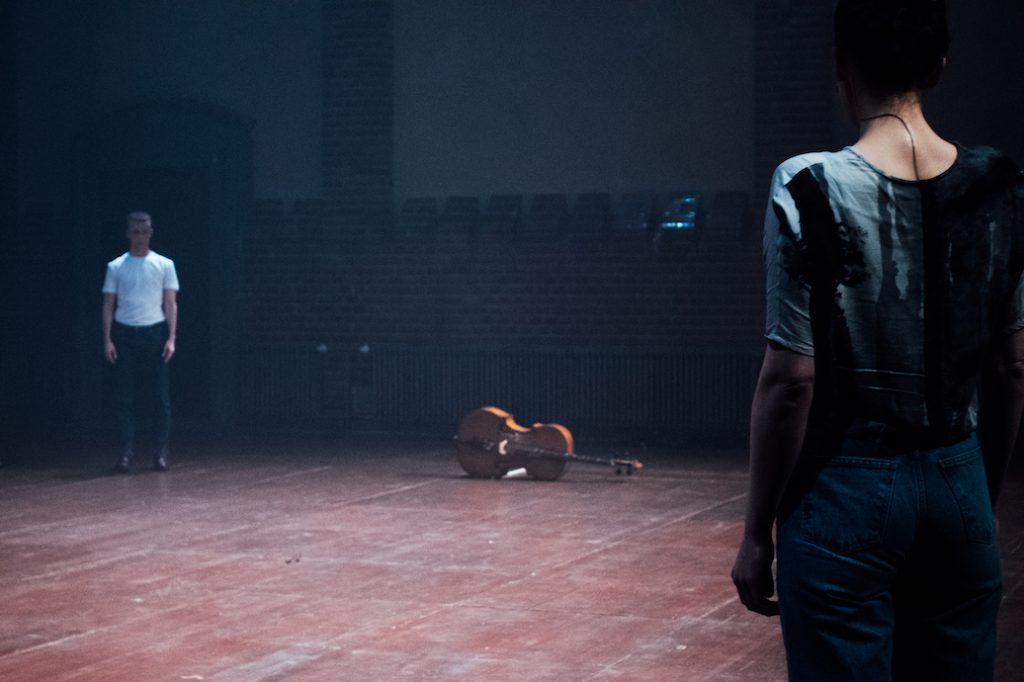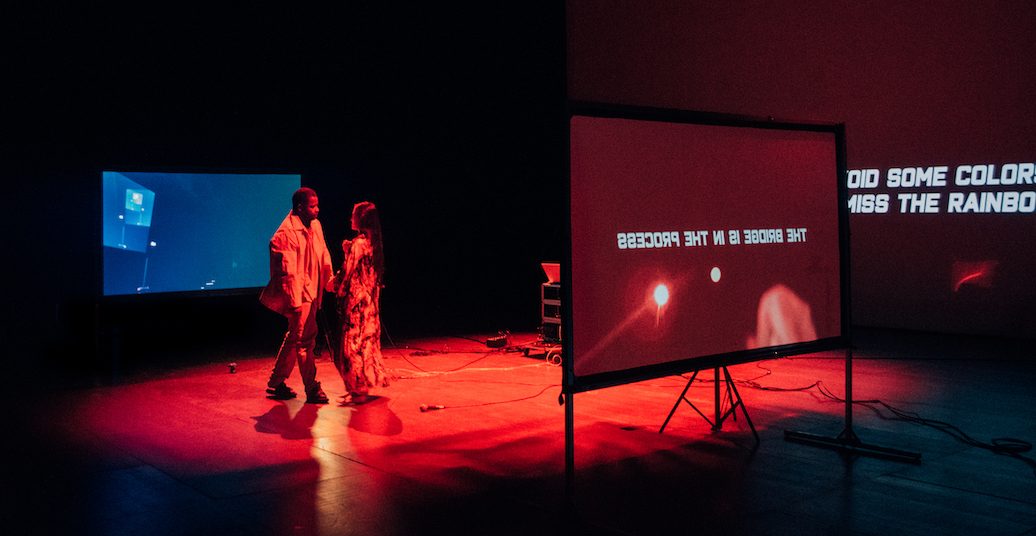Solistenensemble Kaleidoskop’s “LOVE:15”, playing 4-6 March 2022 at radialsystem, was all about how a pair-ship creates a new, unique, and never-finished world. Audience pairs can participate in this creative act, too.
“LOVE:15” was conceived as a celebration of the 15th birthday of Solistenensemble Kaleidoskop, an ensemble founded in Berlin by Michael Rauter and Julian Kuerti to develop new forms of experimental music-theatre. Over the course of a long evening (three hours of active stage time plus a 25-minute intermission), portals into eight little worlds opened and closed again. Each of the worlds was made up of two people, a member of Solistenensemble Kaleidoskop and an outside collaborator. The portals consisted of brief duets, each about 15 minutes long, offering glimpses into an artistic relationship rather than forming complete performance works. Some of the duets displayed incredible chemistry between the performers. Others were effective intellectual partnerships. Some, meanwhile, fumbled, like clumsy new lovers still figuring things out, in ways that were, at times, compelling, and at others, opaque. There were also one or two doomed mismatches, and one solo from someone who had lost his collaborator in the process and instead made his work about her absence.
I knew from the programme notes that Alain Badiou’s In Praise of Love had partially inspired the pair-based structure. The French philosopher’s treatise on romantic love locates its origins in the ‘encounter between two differences,’ but also emphasises love as an ongoing process and warns against the danger of focussing on the first encounter alone. ‘Love,’ he writes, ‘isn’t simply about two people meeting and their inward-looking relationship: it is a construction, a life that is being made, no longer from the perspective of One but from the perspective of Two.’
Spending some time with Badiou after seeing “LOVE:15”, I realised that I was more grateful than I would usually have been to have had a friend with me. After the first half I felt disoriented and unsure what to make of what I’d just seen. Over a beer during the long intermission, my friend and I shared reactions and associations and questions. We had our “Yes, exactly!” moments, and our moments when we realised one of us had seen something the other hadn’t. We tried to unpick how the evening could feel so long and yet so rushed at the same time, and together located our answer to this puzzle in one of the challenges inherent to this kind of setup. It reminded us of the pitfalls we have encountered ourselves in the past, in our own experiences making work for 10-minute play festivals or shared dance bills: the temptation to try to do everything. Many of the duets were based on concepts that could have been developed into evening-length pieces. The duets that we found the most successful were the ones that stayed with one, simple idea — such as Yodfat Miron and Jone San Martin’s Involuntary Meter, which followed the metronome of one performer’s heartbeat through myth and language. In others, we were drawn to specific investigations we wished could have been given more time, including the section of Anna Faber and Lyllie Rouvière’s duet in which they explored the permutations of an encounter between an accordion and their bodies — sounding it with their breasts as impediments to its contractions, manipulating it between their two torsos and pelvises. There was so much more there to be unfolded, but the other elements of their duet crowded out any room to go deeper. “Yes, exactly!” one of us said to the other as we slipped into our seats for the second half. I was aware of watching the rest of the evening with a difference; with the scaffolding of an emerging shared frame — our own interpretive duet.
In the fashion of a good birthday party, “LOVE:15” celebrated who the birthday kid is, and was, while also looking forward with excitement to what comes next. And like a guest at a party, I had moments where I felt carried along by the excitement, others where I felt charmed by new encounters, and plenty of others where I felt bored, lost, confused, or alienated. At such parties, I am always especially grateful for a plus-one, someone to process it all with. As my friend and I walked back towards our neighborhood together, we shared final impressions. Alongside their thoughts, sometimes in tension and sometimes harmony, my thoughts about the evening continued to shift and re-form, even after we parted ways. The programme book contains a conversation between Kaleidoskop ensemble members, in which Boram Lie says: ‘The duos in “LOVE:15” actually represent the essence of how it is that [our ensemble members] want to collaborate, insofar as we see the difference between the partners as a characteristic and not a threat.’ Watching as part of a pair was part of what made it possible for me to appreciate the larger wish of “LOVE:15” — namely, for a way of working that emphasises collaboration as never-finished process, despite the moments in the evening that faltered.

Photo: “LOVE:15”, Solistenensemble Kaleidoskop ©Arnaud Ele
“LOVE:15” by Solistenensemble Kaleidoskop & Guests was shown at radialsystem from 4 to 6 March 2022. Choreography and Performance: Ariel Efraim Ashbel & Daniella Strasfogel, Black Cracker & Mia Bodet, Jone San Martin & Yodfat Miron, Lionel Ménard & Ildiko Ludwig, Lyllie Rouvière & Anna Faber, Nitsan Margaliot & Mari Sawada, Pol Pi & Sophie Notte, Silvia Costa & Michael Rauter. Idea and Concept: Boram Lie.




